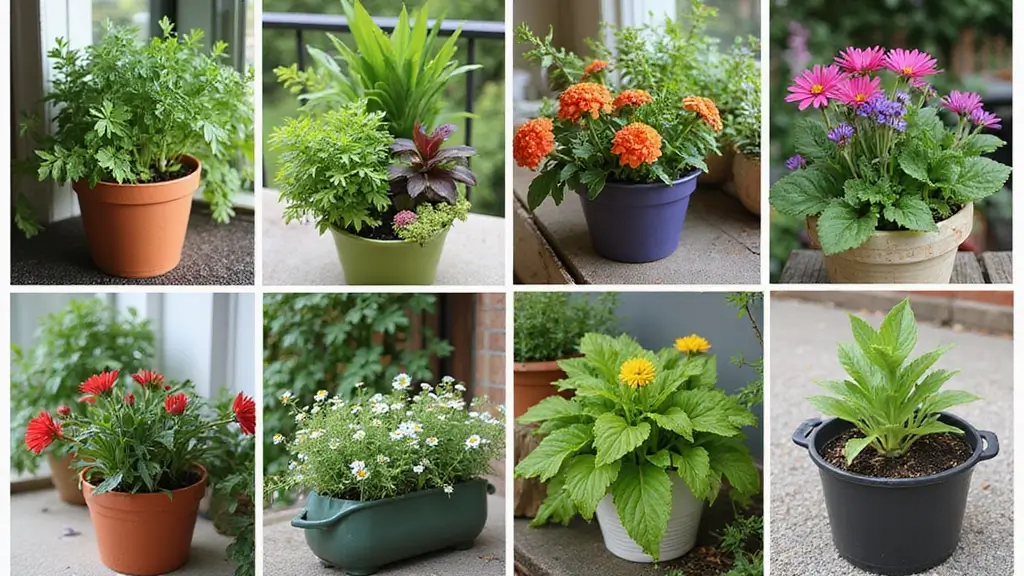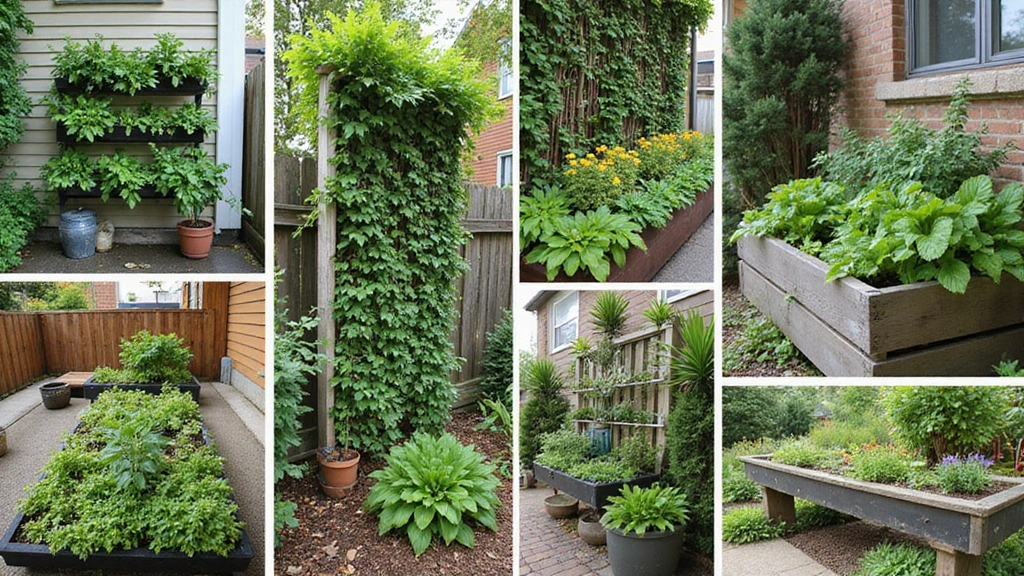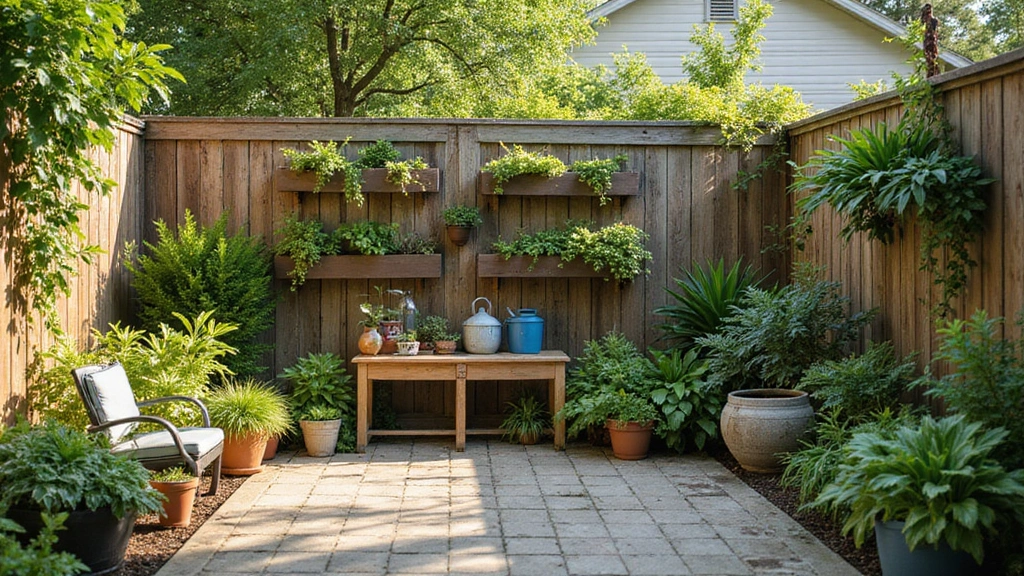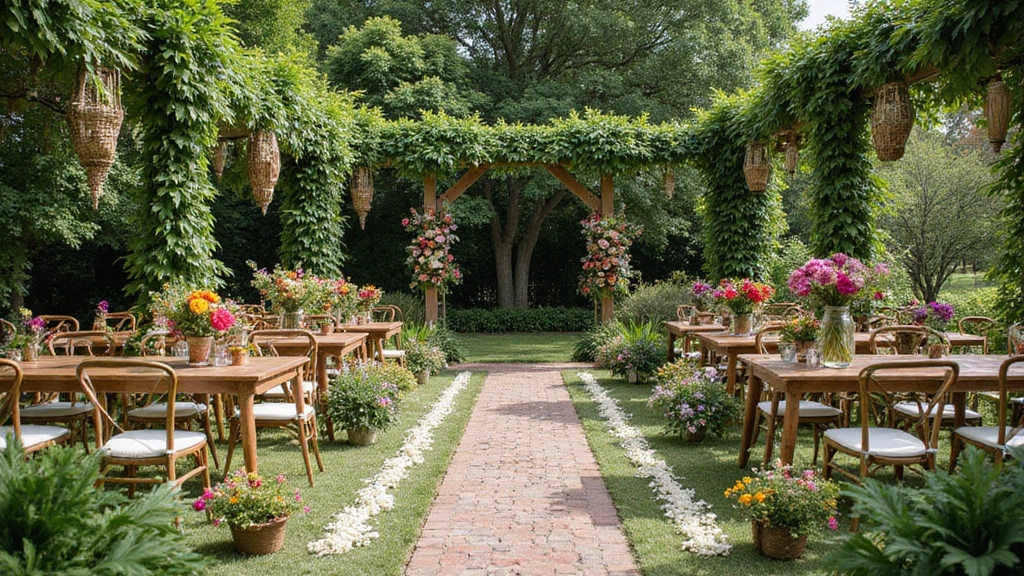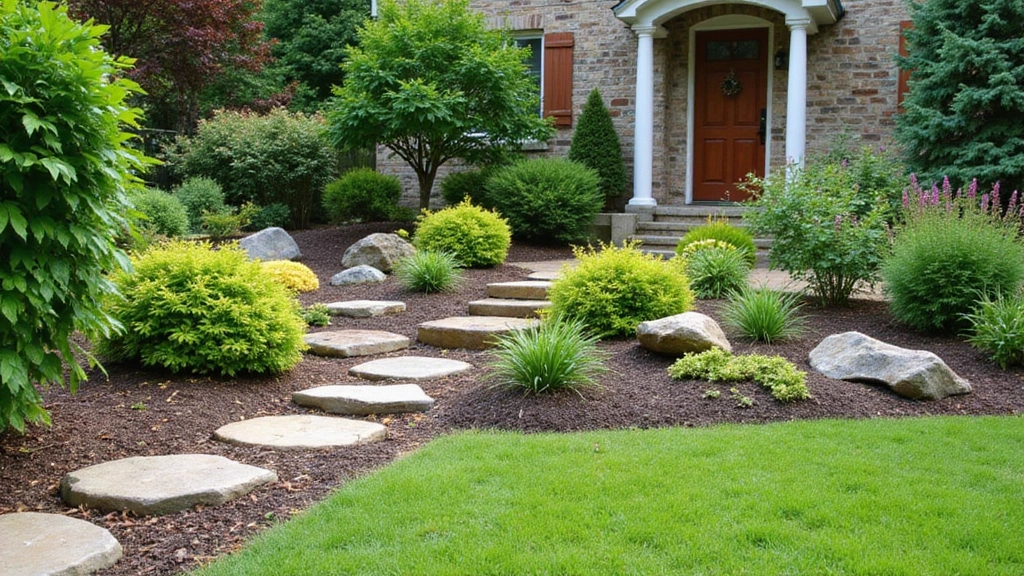Whether you’re an experienced green thumb or just starting, creating a lush garden doesn’t require a sprawling backyard. With some creativity and effort, you can easily bring nature into your small space!
Container gardening is a fantastic solution for urban dwellers or anyone limited on space, making it possible to grow beautiful plants and tasty herbs right outside your door or even indoors. Let’s explore some innovative home gardening ideas that will help you create your very own haven of greenery. Get ready to unleash your inner gardener and transform your living space into an oasis of color and life!
Each idea is designed with simplicity and sustainability in mind, offering you outdoor gardening tips, urban gardening solutions, and container gardening ideas that fit any lifestyle.
1. Vertical Gardens
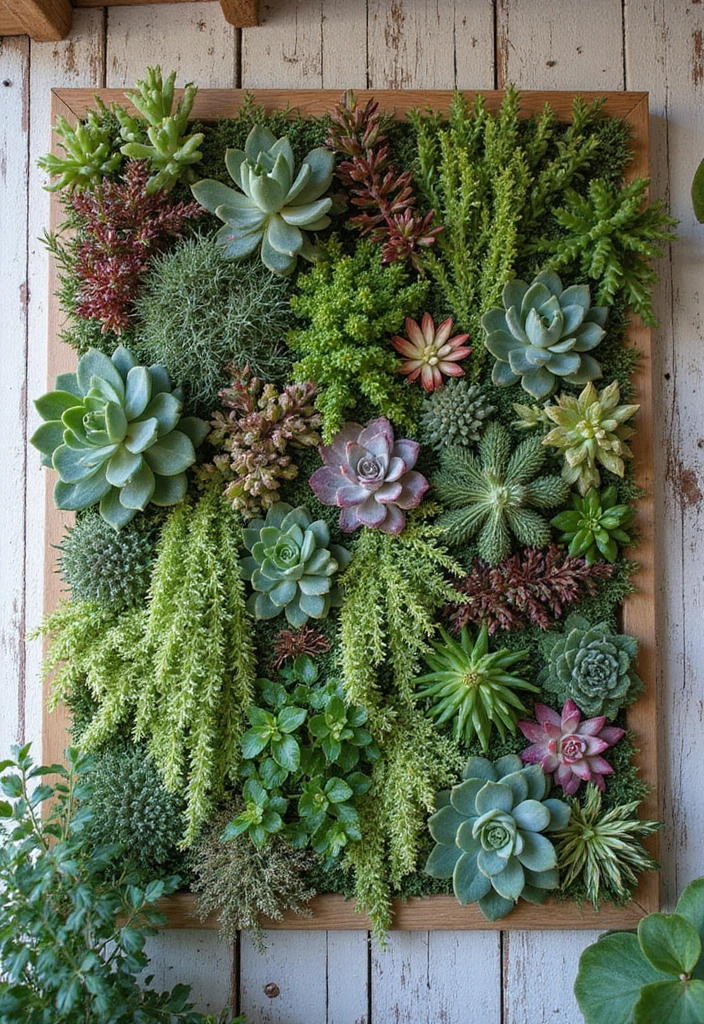
Transform an empty wall into a vibrant vertical garden. This method is perfect for small spaces, as it utilizes height instead of width to showcase your favorite plants. With options like wall-mounted planters, such as the PlantPod Luxe – self-watering wall planters, you can easily create a stunning vertical garden that is both beautiful and functional. These planters are lightweight, making them easy to install without causing strain on your walls.
When selecting pots, opt for lightweight pots that come with drainage holes. This ensures your plants have the right environment to thrive while saving space. The simple modern design of these pots will seamlessly blend into your garden aesthetic.
To keep your vertical garden hydrated without the hassle, consider a drip irrigation system. This system features adjustable nozzle emitters and is perfect for a greenhouse, yard, or raised bed, allowing you to maintain a healthy garden with minimal effort.
Vertical gardens not only save space but also add a stunning aesthetic to your home. Plus, it’s a fun DIY project that can be customized to fit your style!
2. Herb Spiral
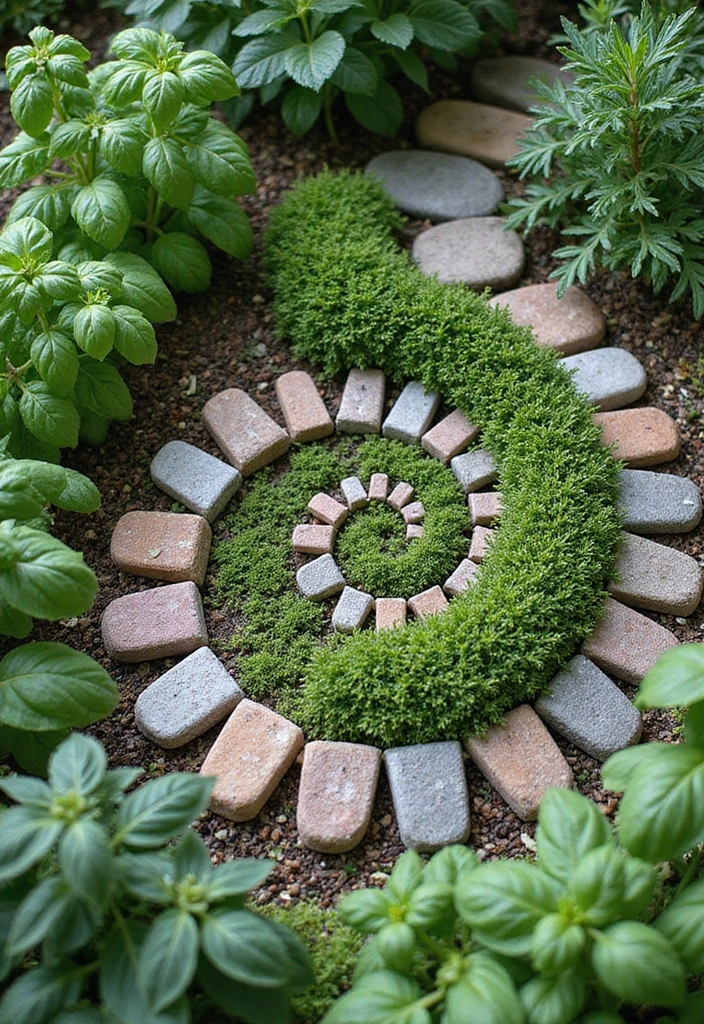
An herb spiral is a compact, creative way to grow a variety of herbs in a small footprint. This spiraled structure allows you to plant herbs with different water needs, making it both functional and visually appealing. To build one, start with a circular base using stones or bricks. Create a spiral shape by stacking materials as you go up, then fill it with soil and plant your favorite herbs in the right spots according to their water requirements (lower for moist-loving herbs, upper for drought-tolerant ones).
To enhance your gardening experience, consider using a soil moisture meter. This handy tool helps you monitor the moisture levels in your herb spiral, ensuring you provide the right amount of water for each herb.
Additionally, you might want to invest in a raised garden bed kit. This will provide a sturdy structure for your herbs while maximizing space and ensuring good drainage.
Finally, don’t forget to add flavor to your herb spiral by planting varieties from an organic herb seeds variety pack. Growing fresh herbs not only enhances your dishes but also engages the senses with delightful aromas and colors while providing easy access during cooking.
3. Hanging Baskets
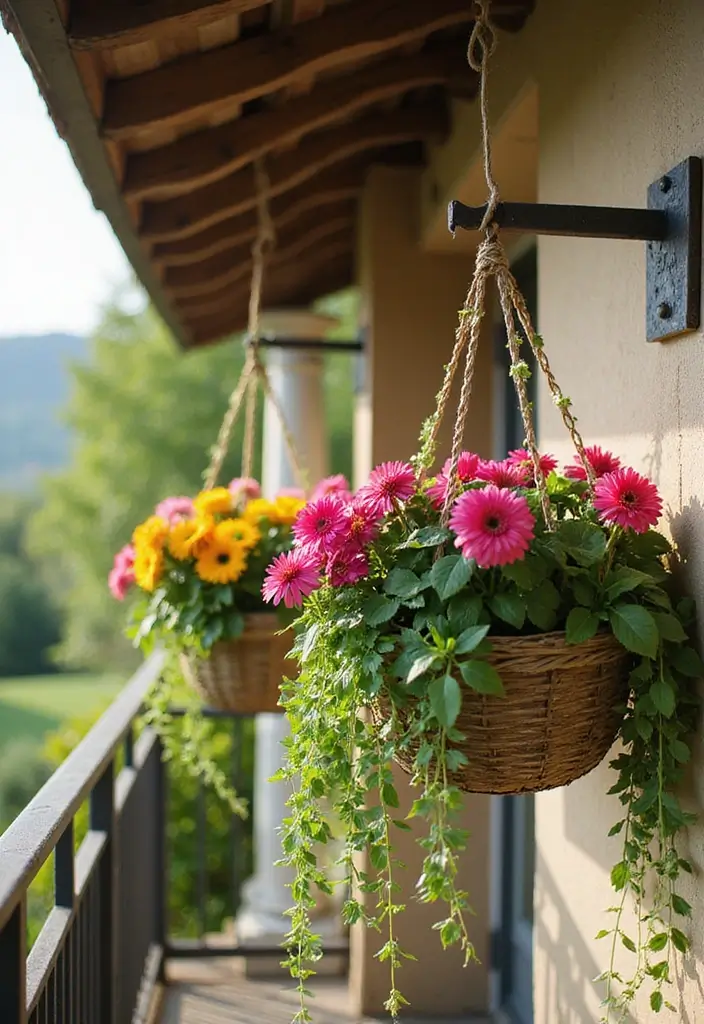
Hanging baskets are a delightful way to add greenery to your space without taking up floor area. They’re perfect for patios, balconies, or even indoors. You can grow flowers, herbs, or even small vegetables such as cherry tomatoes in hanging baskets. To ensure your hanging baskets thrive, selecting the right products is key.
For instance, using a Hanging Basket Planter like the Coconut 1593 Solstice Round Hanging Basket Planter not only provides a stylish look but also ensures proper drainage to prevent root rot. Additionally, opting for a lightweight potting mix, such as Back to the Roots 100% Organic Indoor Potting Mix, will help avoid weighing down your baskets while promoting healthy plant growth.
When selecting plants, choose those that can thrive in a hanging position, such as petunias, ferns, or trailing strawberries. For added convenience, consider a Self-Watering Hanging Basket. This self-watering option is designed to help maintain moisture levels for your plants, ensuring they remain hydrated without constant attention.
Not only do hanging baskets beautify your environment, but they can also create a stunning visual impact by adding layers to your gardening display.
4. Container Vegetable Garden
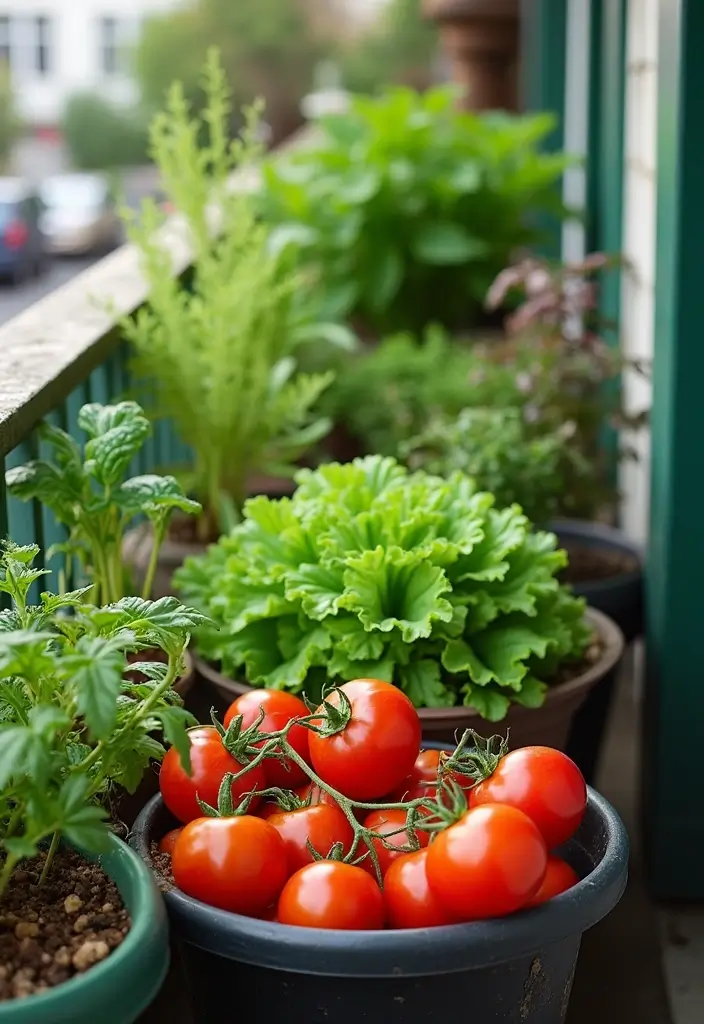
Create a container vegetable garden right on your balcony or patio! Containers make it easy to grow fresh veggies, even in limited spaces. You can choose from a range of containers including pots, troughs, or even recycled materials. To help you get started, consider using self-watering planters, which have drainage holes and saucers to prevent overwatering, ensuring your plants thrive without constant attention.
When selecting what to plant, opt for quick-growing vegetables like radishes, lettuce, or dwarf varieties of tomatoes. To support your plants’ growth, use a high-quality soil mix. The organic potting mix from Burpee is an excellent choice as it’s enriched with nutrients, which helps your veggies flourish in a container garden.
Additionally, having the right tools can make your gardening experience much easier. Consider getting a gardening tool set that includes heavy-duty hand tools and an organizer. This will allow you to efficiently care for your garden and keep everything in one place.
With a little care and the right products, you’ll have fresh vegetables at your fingertips, making your meals healthier and more delicious!
5. Indoor Plant Shelf
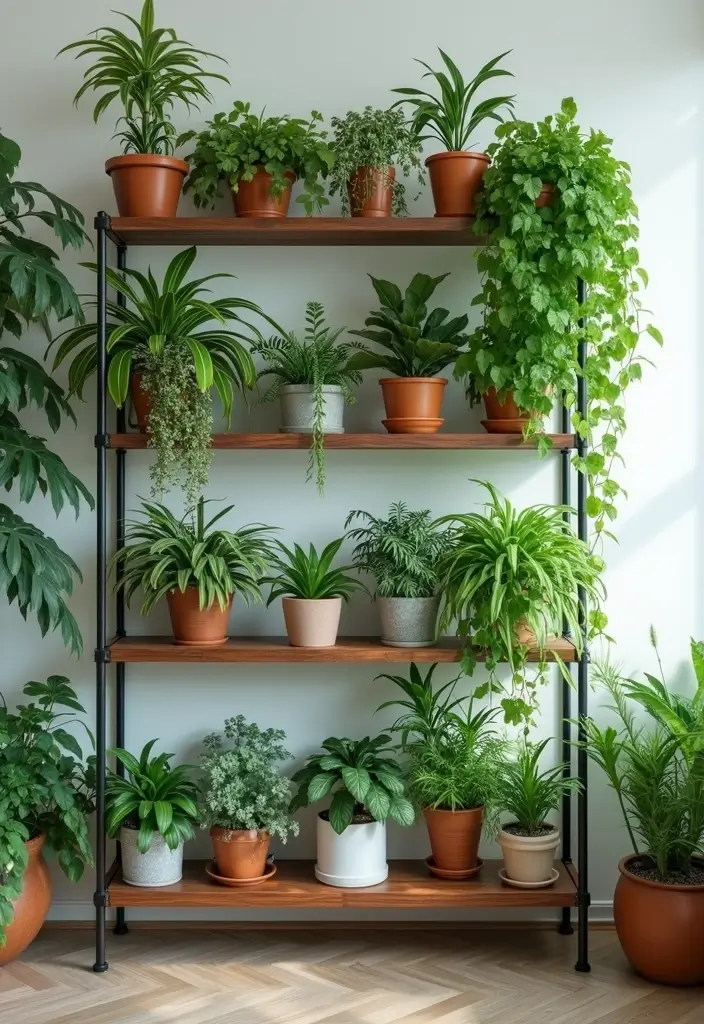
Bring the outdoors inside with an indoor plant shelf! A dedicated shelf can serve as a perfect spotlight for showcasing your favorite houseplants. This idea not only saves space but also enhances your interior decor.
For a stunning plant shelf, consider mixing different sizes and types of plants for visual interest. You can start by using a reclaimed wood plant shelf, which adds a rustic touch to your setup. The natural aesthetic of reclaimed wood can beautifully complement various plant styles.
To ensure your plants thrive together, it’s essential to group ones with similar light needs. If your indoor space lacks sufficient natural light, incorporating indoor grow lights can be a game-changer. These full-spectrum clip lamps offer adjustable brightness levels and timing options, making it easy to create an optimal growing environment.
Finally, to fill your shelf with beautiful greenery, consider the assorted houseplants set. This collection of live houseplants comes with containers and potting soil, providing a hassle-free way to start your indoor garden.
Indoor plant shelves can dramatically change the ambiance of any room while also purifying the air, making them a win-win for your health and aesthetics!
6. Mason Jar Herb Garden
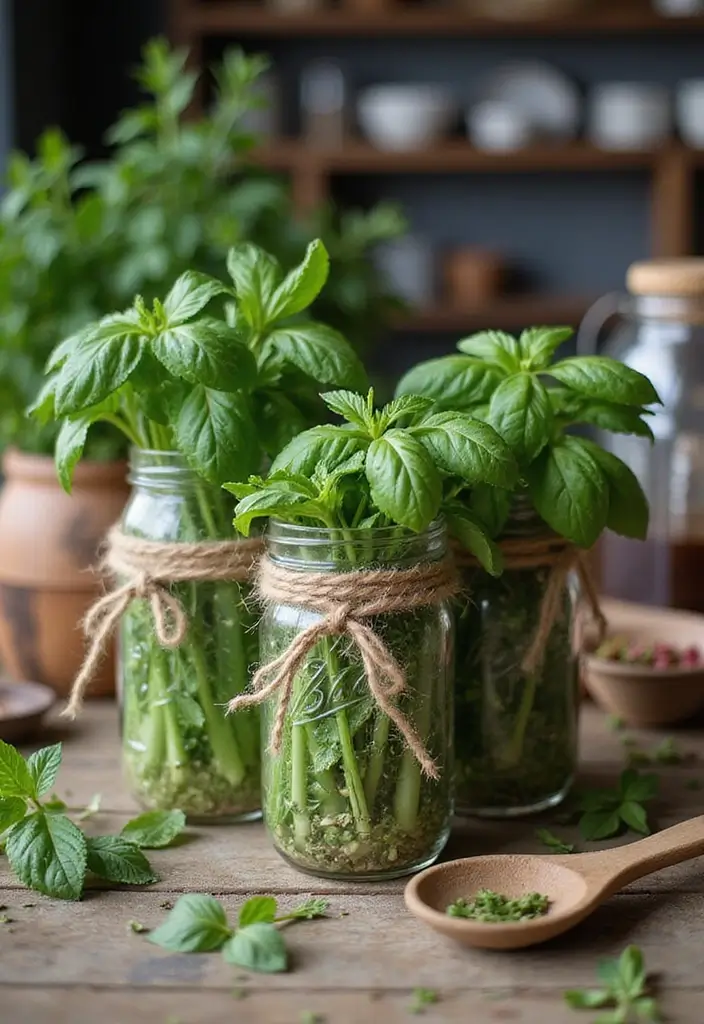
Repurpose old mason jars into charming herb planters! This DIY project is perfect for those with limited space and can easily fit on a windowsill or kitchen counter.
Here’s how to make your own:
– Fill the jars with Miracle-Gro potting mix to provide a nutrient-rich environment for your herbs, ensuring they get the right balance of moisture and aeration.
– Choose your favorite herbs such as basil, cilantro, or mint using an herb seed starter kit which offers a variety of non-GMO heirloom seeds, helping you grow fresh culinary herbs right at home.
– Place them in a sunny spot and regularly water to keep them thriving.
– For added flair, you can decorate the jars with mason jar herb garden labels that allow you to easily identify your herbs and maintain a neat display.
Not only does this create an aesthetic display, but it also makes fresh herbs readily available for cooking!
7. DIY Vertical Planter Boxes
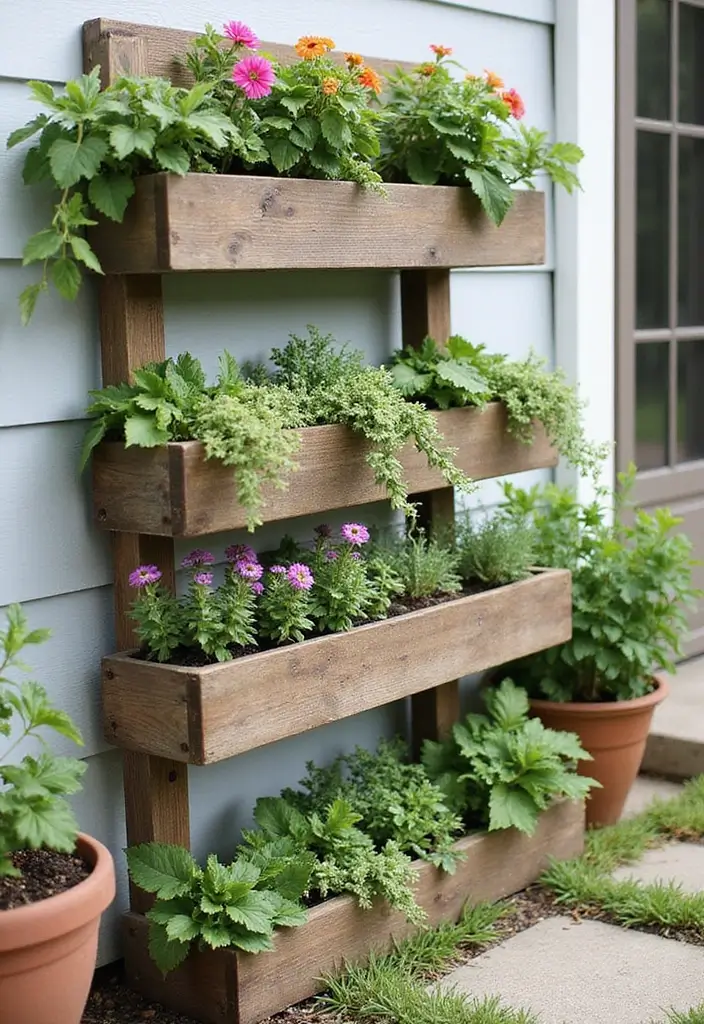
Create your own vertical planter boxes for a unique take on container gardening. These boxes can be stacked or arranged against a wall, maximizing space while allowing you to grow a variety of plants. To build them, start with untreated wood for planter boxes to ensure they are sturdy and safe for your plants. Remember to drill drainage holes, which is essential for keeping plants healthy; using an auger drill bit for planting can make this task easier and more efficient.
Once your boxes are ready, fill them with quality potting mix to provide the best environment for your flowers or vegetables. They’re not only effective space-savers but also add rustic charm to your garden while providing easy access to your plants.
With DIY vertical planter boxes, even the smallest spaces can bloom! Maximize your green space and add rustic charm while making plant care a breeze. Your garden dreams are just a project away!
8. Window Box Gardens
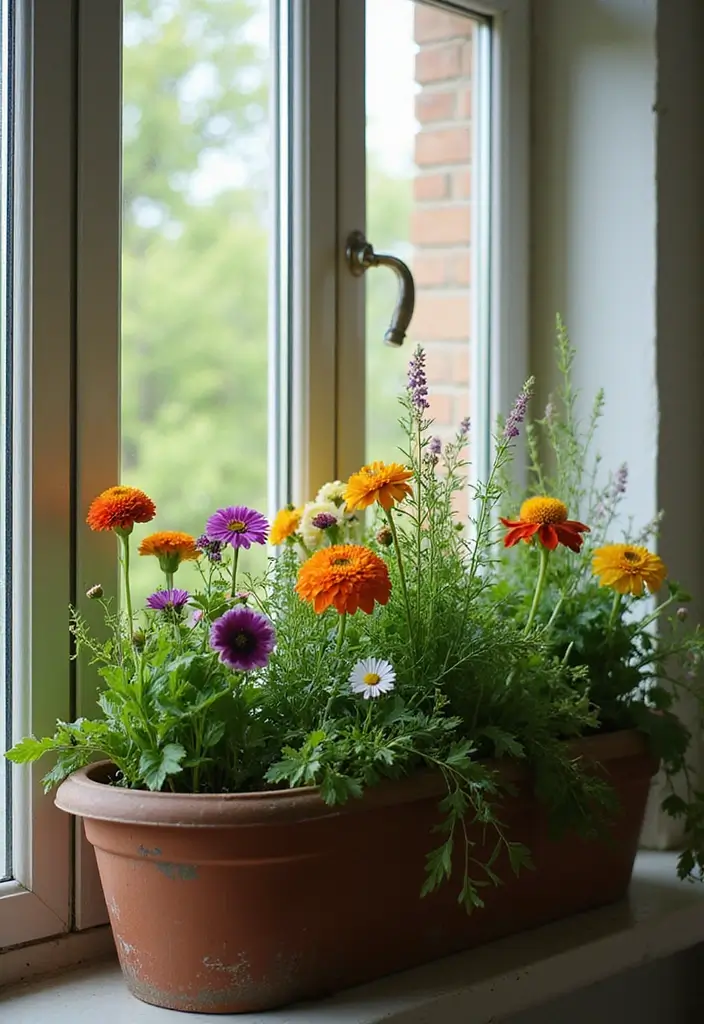
If you have a bit of sill space, window box gardens can be a great way to bring life to your home. They add a beautiful touch to any window while allowing you to grow herbs, flowers, or even small vegetables.
Here’s how to create the perfect window box:
– Choose a box that fits your window size and complements your home’s style. Consider the Mayne Fairfield 3-Foot Window Box, which is self-watering and weather-resistant, making it durable for outdoor use.
– Select plants that are suitable for the sunlight available at the window.
– Ensure proper drainage and use lightweight soil to avoid sagging. The Back to the Roots 100% Organic Indoor Potting Mix is a great option as it promotes healthy plant growth and is easy to handle.
To help keep your plants hydrated without worry, consider adding self-watering planter inserts. These glass rainbow plant watering globes will automatically water your plants, ensuring they receive the moisture they need.
Window boxes not only beautify your space but also attract bees and butterflies, enhancing your garden’s ecosystem.
9. Succulent Garden
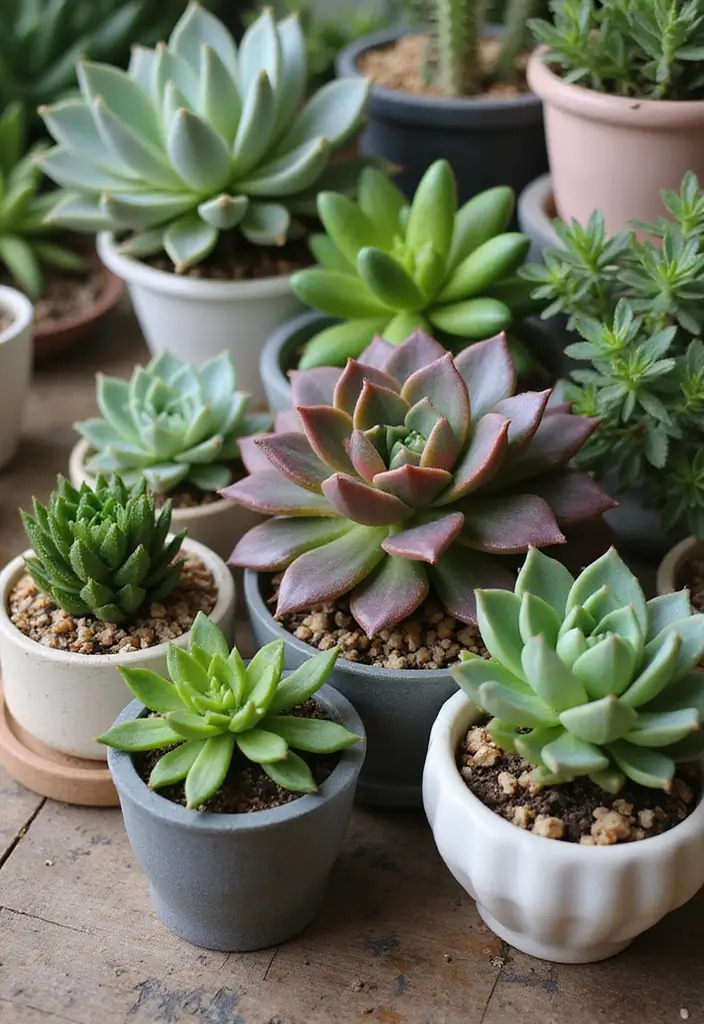
Succulents are fantastic for small spaces thanks to their low-maintenance nature. You can create an adorable succulent garden in containers, pots, or even in glass terrariums. To ensure your succulents thrive, it’s essential to have the right supplies.
Start with Cactus and Succulent Potting Soil, which is specially designed for these plants. This well-draining soil mix provides the premium nutrition they need, helping prevent overwatering and root rot.
Next, consider using a Glass Terrarium Kit. This stylish option allows you to showcase your succulents while creating an ideal environment. The glass structure not only enhances the aesthetic appeal but also offers protection and humidity control, making it perfect for succulents.
Lastly, a good watering routine is key. A watering can with measured spout ensures you can water sparingly and accurately, allowing the soil to dry out between watering sessions.
Creating a succulent garden can be a fun project, and with the right products, their diverse shapes and colors will add a unique touch to your decor!
10. Edible Flower Pots
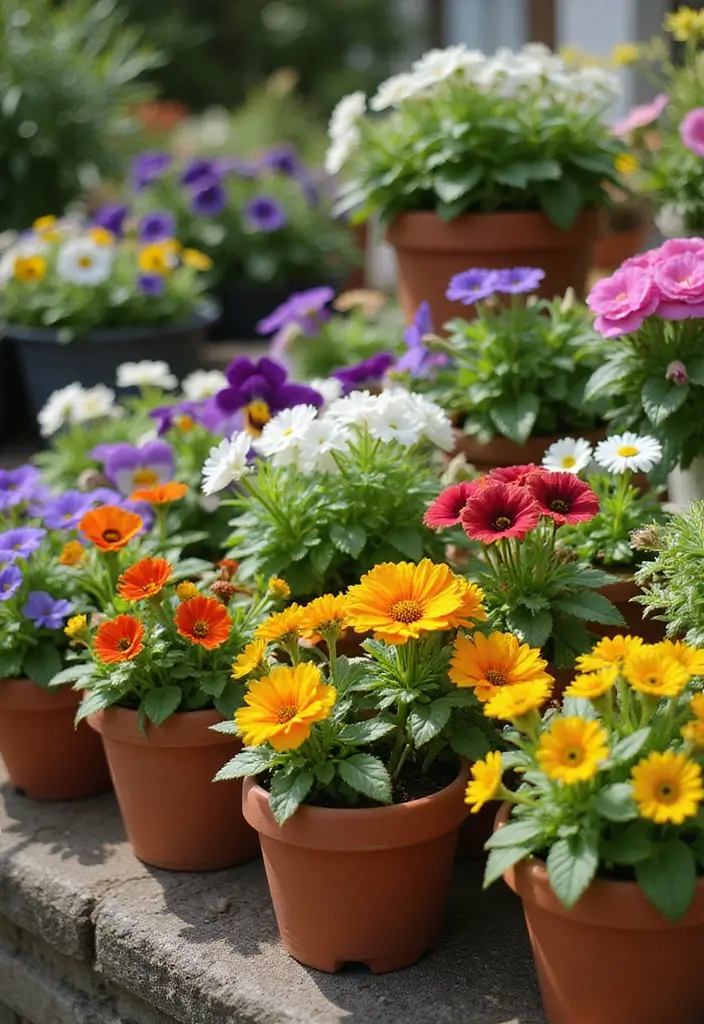
Why not add beauty and flavor to your garden with edible flowers? Pots filled with edible blooms such as nasturtiums, pansies, or marigolds can beautify your space and be used in your culinary creations. To get started, consider using the organic edible flower seeds variety pack, which includes a selection of safe-to-eat flowers like violets and calendula that will not only add color but also have unique flavors.
When planting, it’s crucial to have the right soil. Using a high-quality product like the high-quality potting soil mix for edible plants ensures that your flowers thrive in nutrient-rich conditions, promoting vibrant growth and blooming.
Make sure to choose pots with good drainage, such as the decorative planter pots with drainage. These pots are not only functional but also add a stylish touch to your garden decor. Position your pots in a sunny location and regularly deadhead to encourage blooming.
Adding edible flowers creates not just a feast for the eyes but also adds unique flavors to your salads and drinks!
11. Climbing Plants on Trellises
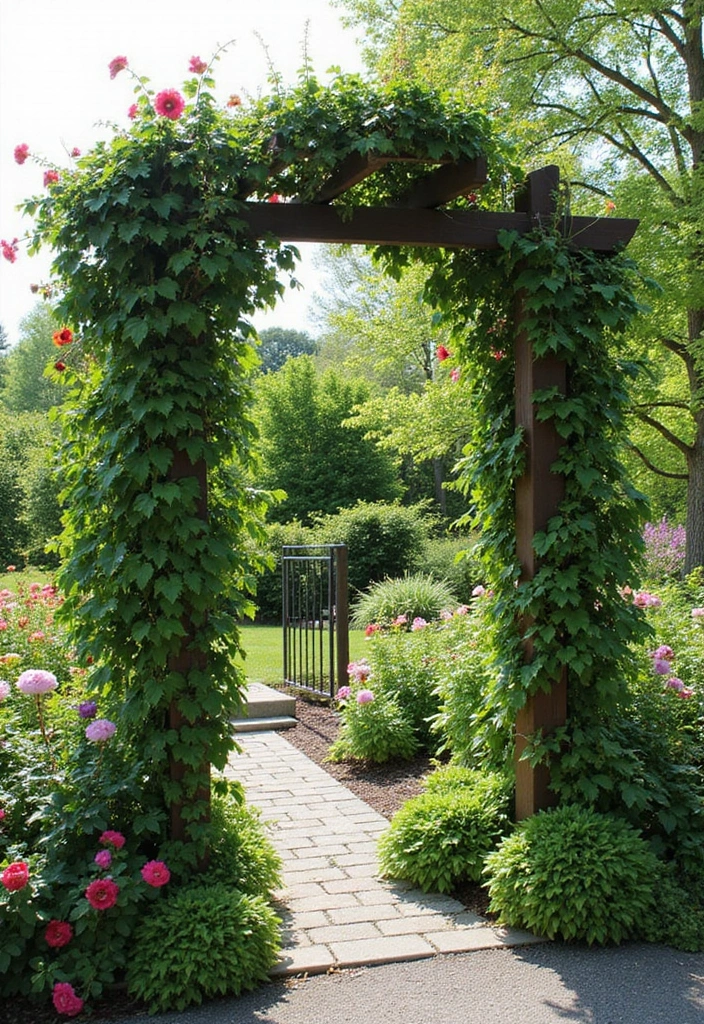
Utilize vertical space by growing climbing plants on trellises, which can add dimension to your garden while optimizing small areas. Climbing beans, peas, or flowering vines can create a lush green backdrop. To support these beautiful plants, consider using the RUBFAC Metal Garden Arch. This sturdy trellis is designed to hold the weight of various climbing plants, making it an ideal choice for your garden.
When setting up your trellis, position it in a sunny spot for optimal growth. Training your plants to grow onto the trellis as they mature is essential, and for that, plant training clips can be very helpful. These clips allow you to gently guide your plants as they climb, ensuring they grab onto the structure effectively.
Additionally, to kickstart your climbing garden, you might want to purchase some seeds. Consider the climbing plant seeds, which include options like beans, peas, and flowering vines. These non-GMO seeds provide a fragrant and vibrant touch to your garden.
This method not only maximizes space but also enhances privacy and shade in your outdoor area! Grow upwards, not outwards, and bring your garden to life with vibrant colors and lush greenery. Maximize your small space and enjoy a beautiful vertical paradise!
12. Repurposed Furniture Planters
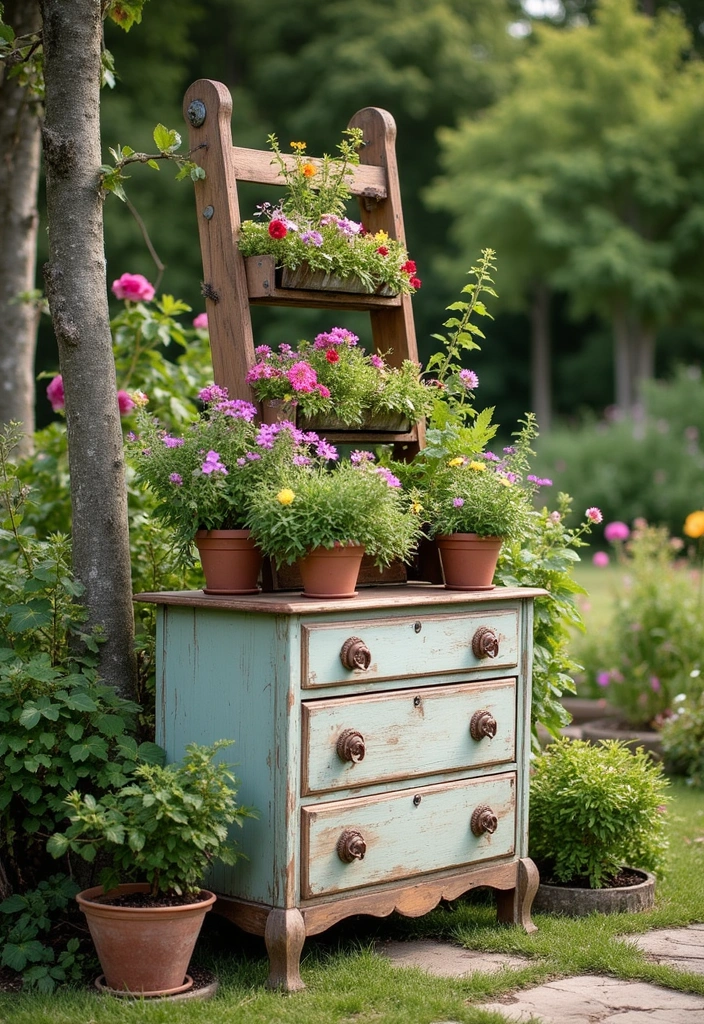
Transform old furniture into unique planters! An old dresser, bookshelf, or even a wooden ladder can be creatively repurposed to host a variety of plants. This not only gives new life to discarded items but also adds character and style to your garden, serving as an eye-catching conversation piece.
For instance, you can use drawers from an old dresser as planters by adding a plastic liner, such as the plastic liner for planters, which provides a protective layer and helps retain soil moisture while preventing leaks.
If you have an unused ladder, consider turning it into a tiered plant stand. A perfect option for this is the wooden ladder plant stand, designed to hold multiple potted plants while bringing an attractive vertical element to your space.
An old bookshelf can be transformed into a garden shelf, offering a sturdy and stylish way to display your plants. The garden shelf for plants provides ample space for various pots, making it a practical addition to your indoor or outdoor décor.
By utilizing these ideas and products, you can enhance your gardening experience while making sustainable choices!
13. Fairy Gardens
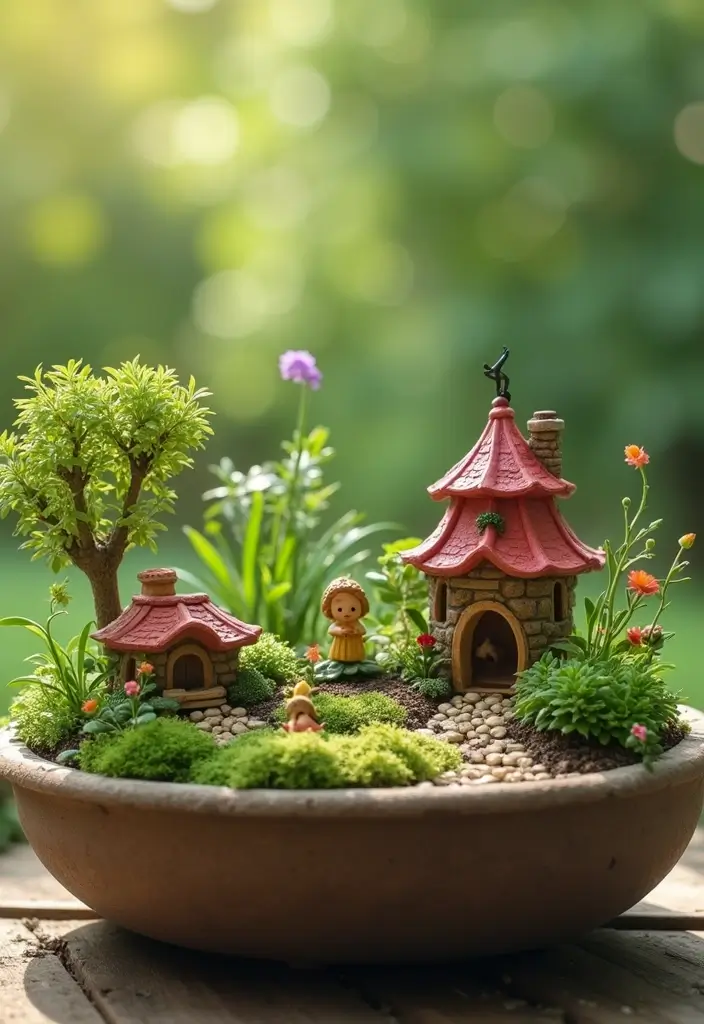
Create a magical fairy garden that captures the imagination! These miniature gardens can be designed in any container, allowing you to include small plants, pebbles, and tiny decorations.
To craft your fairy garden, start with a shallow container or dish like the shallow planting container from Arcadia Garden Products. This perfect base will provide ample space for your design.
Next, select small, slow-growing plants such as moss, ground cover, or mini succulents. Consider the mini succulent plants that come in a 20-pack, providing a variety of options to choose from for your enchanting landscape.
Finally, add tiny accessories to enhance the whimsical scene, like the fairy garden accessories set, which includes charming items such as bridges, houses, and figurines.
Fairy gardens are not just for kids; they can add a fun and artistic touch to your space while encouraging creativity!
Transform your small space with a touch of magic! A fairy garden is not just a child’s play—it’s a delightful way to unleash creativity and bring your home gardening ideas to life.
14. Indoor Seed Starting
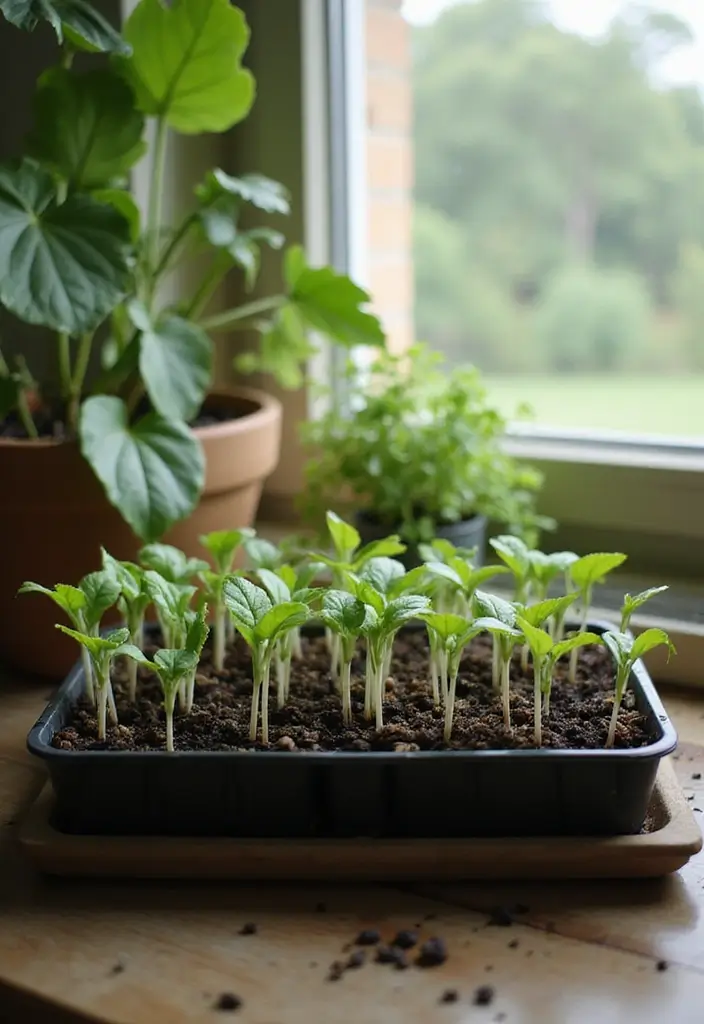
Start your gardening journey indoors by seed starting! This allows you to get a jump on the growing season, and it’s a fun project for anyone looking to grow their favorite vegetables or flowers from scratch.
To successfully start seeds indoors, consider using Burpee SuperSeed seed starting trays. These trays are designed with 16 extra-large cells and are reusable and dishwasher safe, making them perfect for starting vegetable, flower, and herb seeds. They provide the right amount of space for seedlings to thrive.
Next, ensure your plants receive sufficient light. A great option is the GooingTop LED grow light, which features a full spectrum of light to support healthy growth. With its 5-level dimmable settings and automatic on/off timing, it simplifies the lighting process, allowing you to focus on nurturing your plants.
Finally, keeping the soil in your seed trays moist but not soggy is essential for effective germination. For this, consider using Back to the Roots 3-in-1 seed starting mix. This organic mix is enriched with nutrient-rich plant food and worm castings, helping to maintain moisture and provide the necessary nutrients for your seeds.
Watching your plants grow from seeds to seedlings is incredibly rewarding, and with these products, you’ll have a head start when it comes time to transplant outdoors!
15. Pollinator-Friendly Gardens
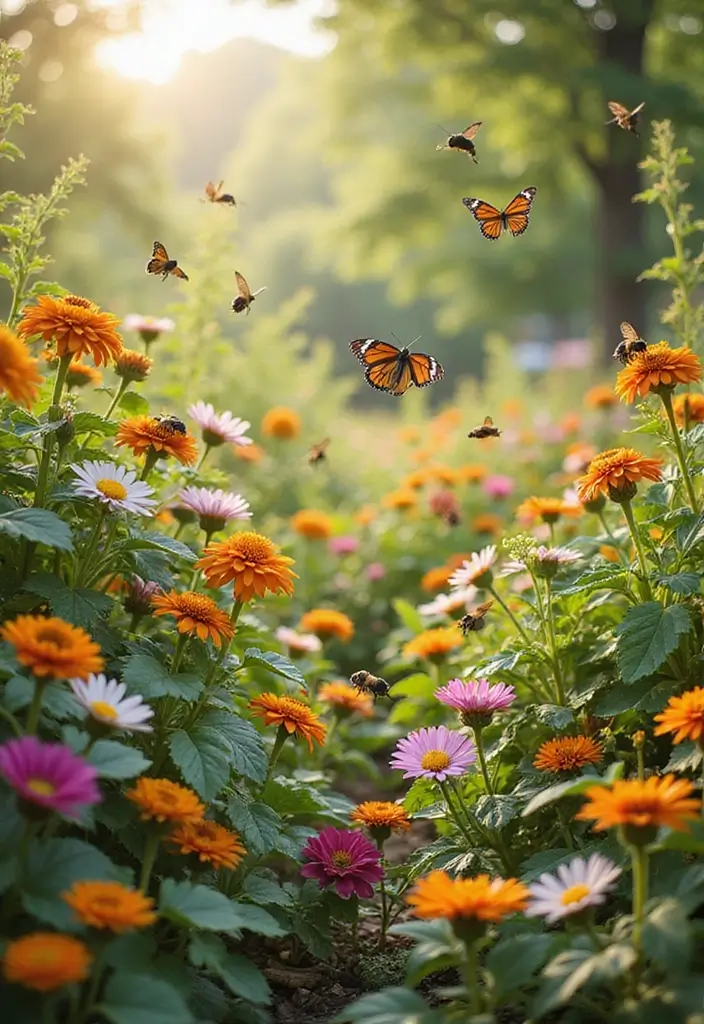
Create a haven for pollinators by planting a pollinator-friendly garden! This helps support local wildlife while adding a splash of color to your space.
To attract bees and butterflies:
– Select native plants that provide nectar and pollen. For an easy start, consider using native wildflower seed mix, which includes over 7,500 seeds of open pollinated and non-GMO varieties suited for your region.
– Incorporate flowers of various shapes and colors to attract diverse pollinators.
– Avoid using pesticides to keep your garden safe for these important creatures.
Additionally, creating habitats for these beneficial insects can increase your garden’s appeal. A bee hotel can provide a safe nesting site for solitary bees and other pollinators, enhancing the biodiversity of your space.
By fostering a pollinator-friendly garden, you support biodiversity and can enjoy the beauty of nature buzzing around your green space.
16. Composting for Garden Health
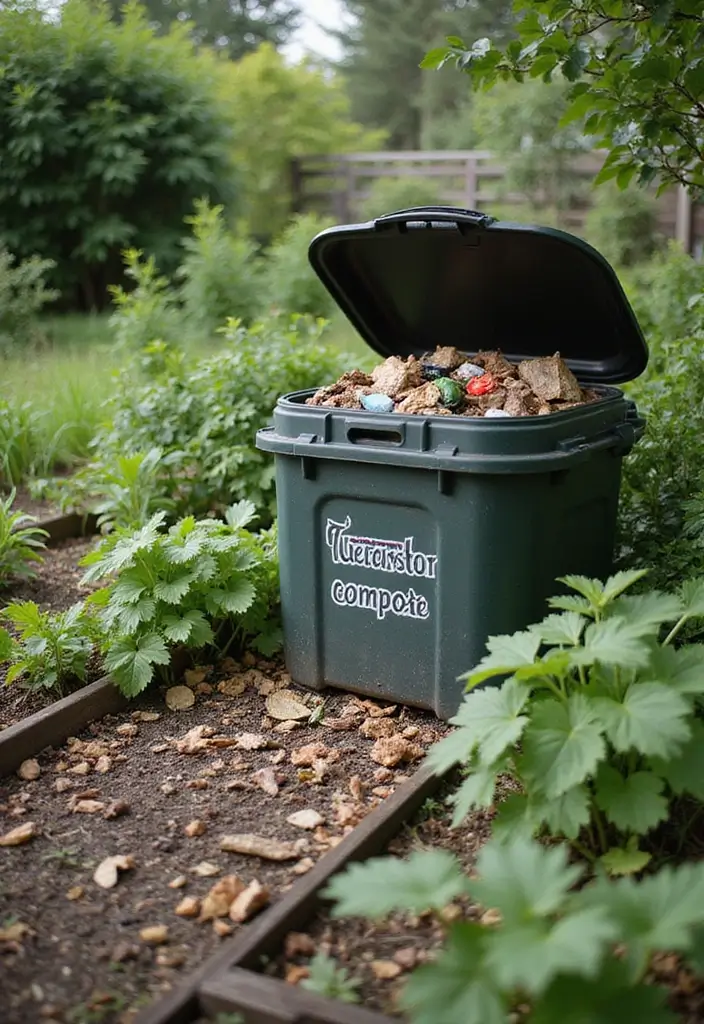
Composting is an eco-friendly practice that benefits your garden while reducing waste. It enriches soil, helping plants thrive by providing essential nutrients.
Getting started is simple:
– Choose a compost bin or create a pile in your yard. A great option is the OXO Good Grips easy-clean compost bin, which is compact and easy to use, making it perfect for small spaces or kitchen collection.
– Add kitchen scraps, yard waste, and other biodegradable materials. To collect kitchen waste conveniently, consider the Utopia Kitchen compost bin. This stylish countertop compost bucket not only holds 1.3 gallons but also includes a spare charcoal filter to keep odors at bay.
– Turn the pile regularly to aerate and speed up decomposition. Enhance this process with the EJWOX stainless steel compost aerator tool. This manual turner and mixer will help ensure your compost breaks down faster and more efficiently.
Using compost in your garden not only promotes healthy plant growth but also contributes to sustainable gardening practices. With the right tools, you can make composting an easy and rewarding part of your gardening routine.
17. Raised Garden Beds
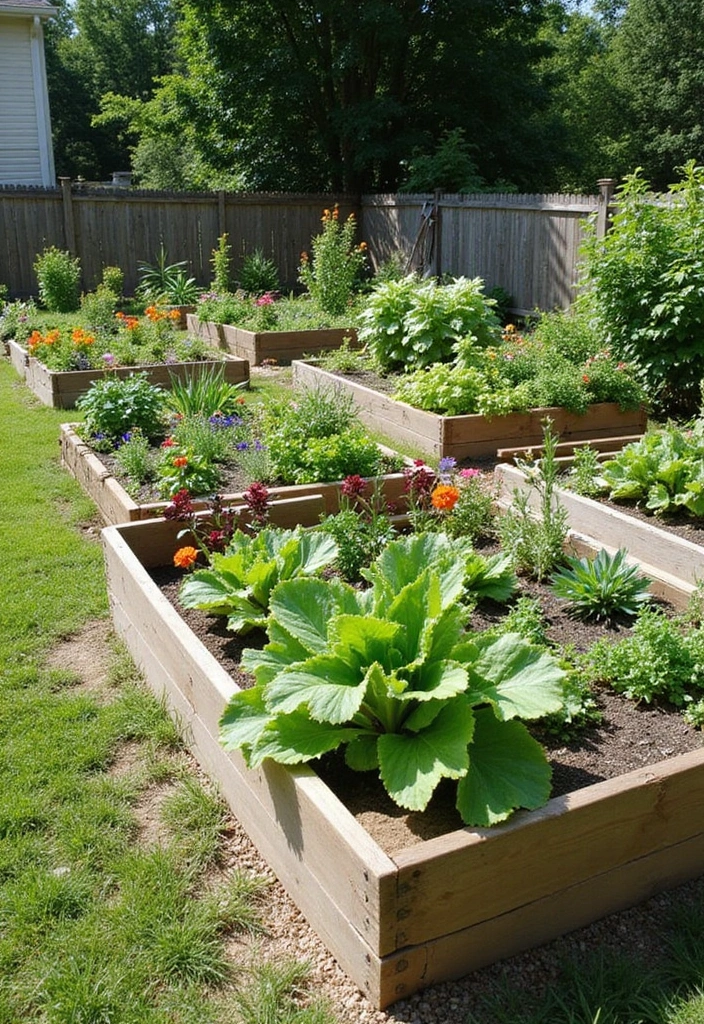
Raised garden beds are a practical solution for those with limited mobility or poor soil conditions. They elevate your plants, making gardening easier while providing better drainage and soil warmth. To get started, consider using Infinite Cedar Premium Cedar Raised Garden Bed, which is handcrafted from rot-resistant North American Western Red Cedar wood for durability.
Next, fill your raised beds with a mix of quality soil and compost, such as Espoma Organic Raised Bed Mix. This all-natural and organic potting soil mix provides the essential nutrients your vegetables and herbs need to thrive.
To make the planting process even easier, a good set of tools is indispensable. The Gardening Tools 9-Piece Heavy Duty Gardening Hand Tools Set offers everything you need, complete with an organizer handbag to keep your tools rust-proof and ready for use.
Raised beds not only improve your gardening experience but also create defined spaces in your garden, enhancing its neat and organized appearance. Enjoy the ease of access and the beauty of a thriving green space!
18. Seasonal Plant Rotation
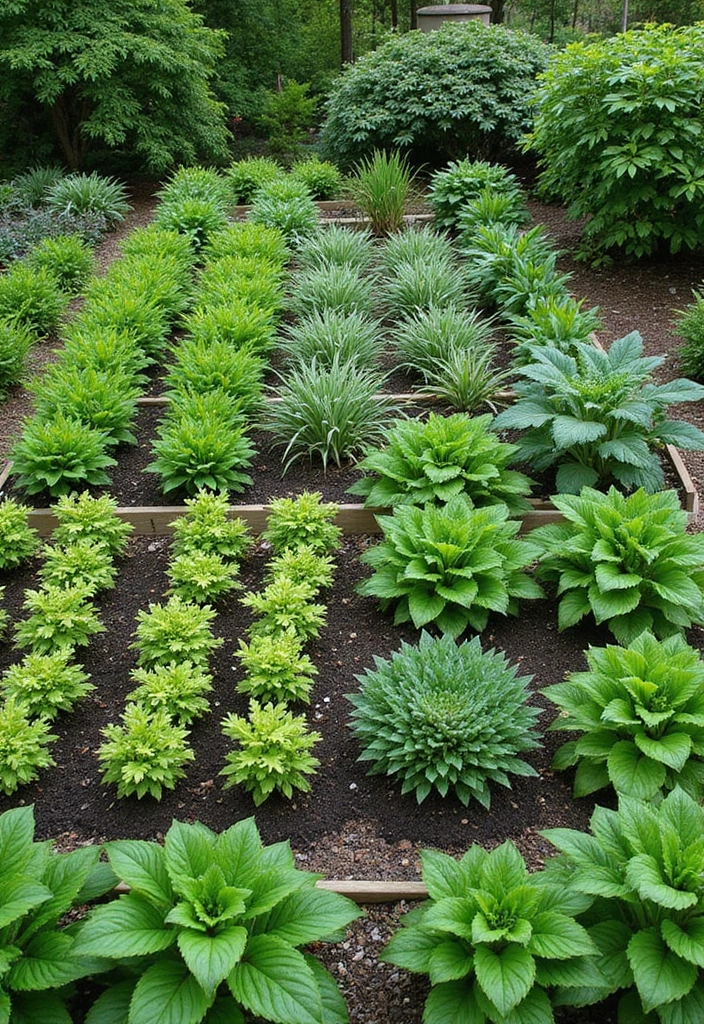
Practice seasonal plant rotation to maintain soil health and prevent pests. This gardening technique involves changing the location of plants each season to ensure they receive different nutrients and reduce soil-borne diseases.
To implement this method effectively, consider using a Garden Planner Journal to map out your garden layout for each season. This journal will help you keep track of where each plant will go, ensuring that you rotate your crops like legumes, leafy greens, and root veggies for a balanced approach.
Additionally, a Soil Test Kit can be incredibly valuable. By accurately measuring soil pH and nutrient levels, you can make informed decisions about what to plant where, further enhancing the health of your soil.
Finally, maintaining a gardening journal can also be immensely helpful. Consider the Crop Rotation Guide, which allows you to track what you planted, where, and when, ensuring a productive garden year after year.
This method not only keeps your garden healthy but also enhances biodiversity, making your gardening efforts more sustainable.
19. Indoor Hydroponics
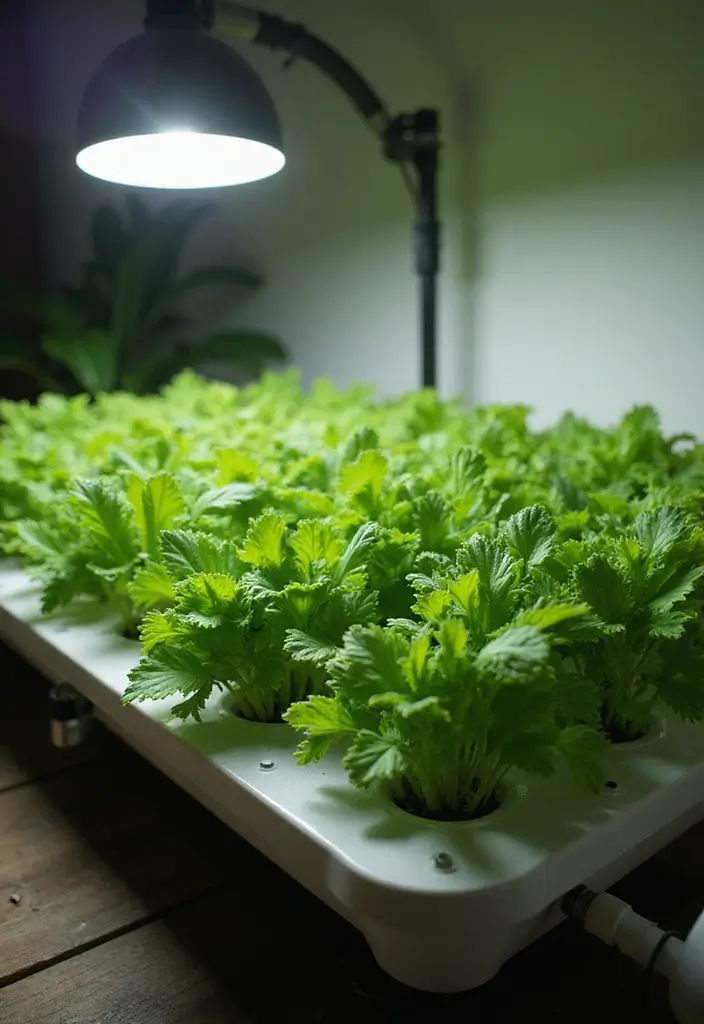
Hydroponics allows you to grow plants without soil, using nutrient-rich water instead! It’s perfect for urban gardening solutions and can be set up indoors or outdoors.
To start a hydroponic garden, you’ll want to choose a hydroponic system, such as nutrient film technique or deep water culture. A great option to consider is the Ahopegarden Indoor Garden Hydroponics Growing System, which features a 10 pods plant germination kit and an LED grow light for optimal growth indoors.
Selecting appropriate plants like lettuce, herbs, or strawberries is also key. To ensure your plants thrive, it’s essential to monitor pH levels and nutrient content regularly. The pH Meter for Hydroponics is a useful tool that allows for simultaneous measurement of pH, conductivity, TDS, and temperature, making it easier to maintain the right conditions for your hydroponic garden.
In addition, incorporating the right nutrients is crucial for plant health. The General Hydroponics Flora Series provides a complete 3-part hydroponic nutrient system, ensuring your plants receive the necessary nourishment for faster growth rates.
This innovative method saves space and can lead to a thriving green space, making it an exciting option for home gardening enthusiasts.
20. Natural Pest Control
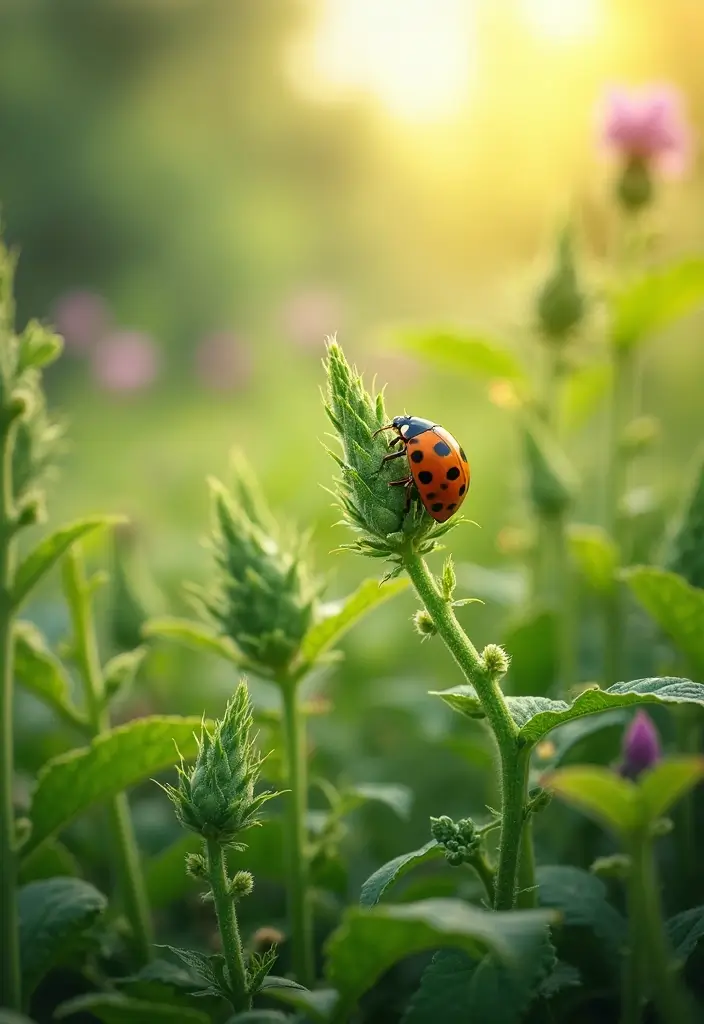
Keep your garden healthy by using natural pest control methods that promote a balanced ecosystem while minimizing harmful chemicals.
Effective strategies include introducing beneficial insects, such as ladybugs or lacewings, which can prey on common garden pests. You can easily enhance your pest management by adding a Beneficial Insects Kit, which contains live beneficial nematodes that kill over 200 different species of soil-dwelling and wood-boring insects.
Another great strategy is companion planting, where certain plants help each other thrive. For example, marigolds are known to deter aphids, making them an excellent addition to your garden. Consider planting Companion Planting Seeds (Marigolds), which come in a pack of over 9,250 non-GMO heirloom seeds for both indoor and outdoor gardening.
Additionally, for those moments when you need a natural pesticide, using neem oil is highly effective. A product like Neem Oil Spray can serve as a multi-purpose fungicide, insecticide, and miticide, making it a valuable tool for organic gardening.
By adopting these natural pest control methods, you can help protect your plants while keeping the environment safe, supporting sustainable gardening practices.
21. Colorful Container Combinations
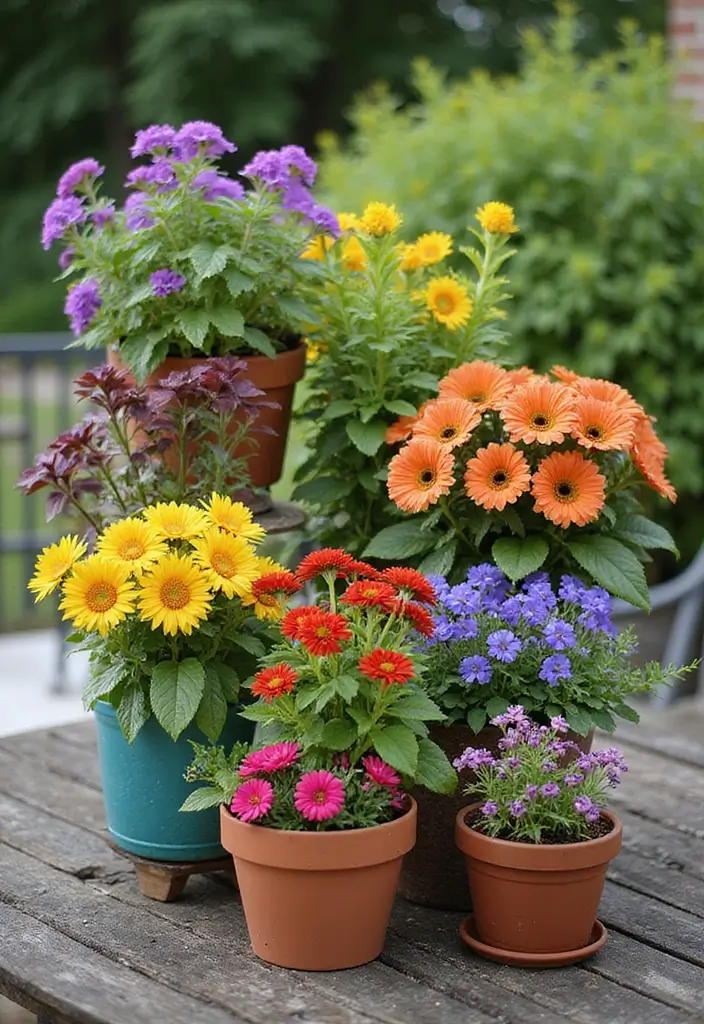
Experiment with colorful container combinations to create stunning visual displays! Mixing different plants in one container can yield striking results. For success, choose plants with varying heights, colors, and textures. Additionally, consider the light and water needs of each plant to ensure they complement each other.
To get started on your container gardening journey, you might want to check out the colorful plant containers. This 16-pack of 4″ plastic flower pots comes in eight different colors, making it easy to create vibrant arrangements.
Don’t forget about the importance of quality soil! Using a reliable potting mix can really boost your plants’ growth. The Gardening Soil Mix from Miracle-Gro is perfect for container plants, providing the right nutrients for flowers, vegetables, and more, feeding your plants for up to six months.
Lastly, maintaining proper hydration is crucial for your plants. A plant care watering can with a long spout not only helps you reach those tricky corners but also ensures your plants receive just the right amount of water.
Using contrasting colors can create dramatic effects, while harmonious palettes offer a more subdued look. This approach not only brings vibrancy to your space but also showcases your creativity, making gardening an enjoyable experience!
22. Aromatic Plant Borders
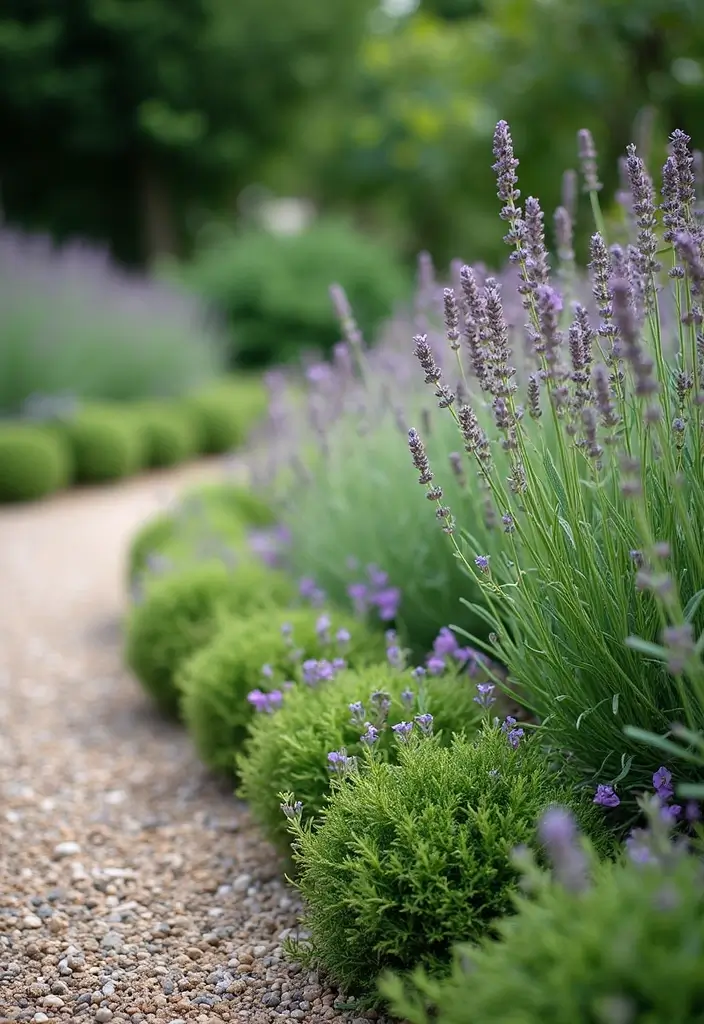
Create aromatic plant borders around your garden to provide sensory experiences and natural barriers. Choosing fragrant herbs or flowers like lavender plants, mint plants, or rosemary plants will enhance your outdoor space with delightful scents and vibrant colors.
To establish aromatic borders:
– Plant the borders in a sunny location for optimal growth.
– Mix different aromatic plants to create layers of scents and colors.
– Utilize these borders not only for beauty but also to deter pests.
Incorporating lavender, known for its calming aroma, can transform your garden into a serene retreat. Mint adds a refreshing scent and is excellent for improving air quality, while rosemary not only boasts a lovely fragrance but also enhances your cooking. Aromatic borders add both functionality and aesthetics to your garden, making it a lovely place to relax and unwind.
23. Community Gardening
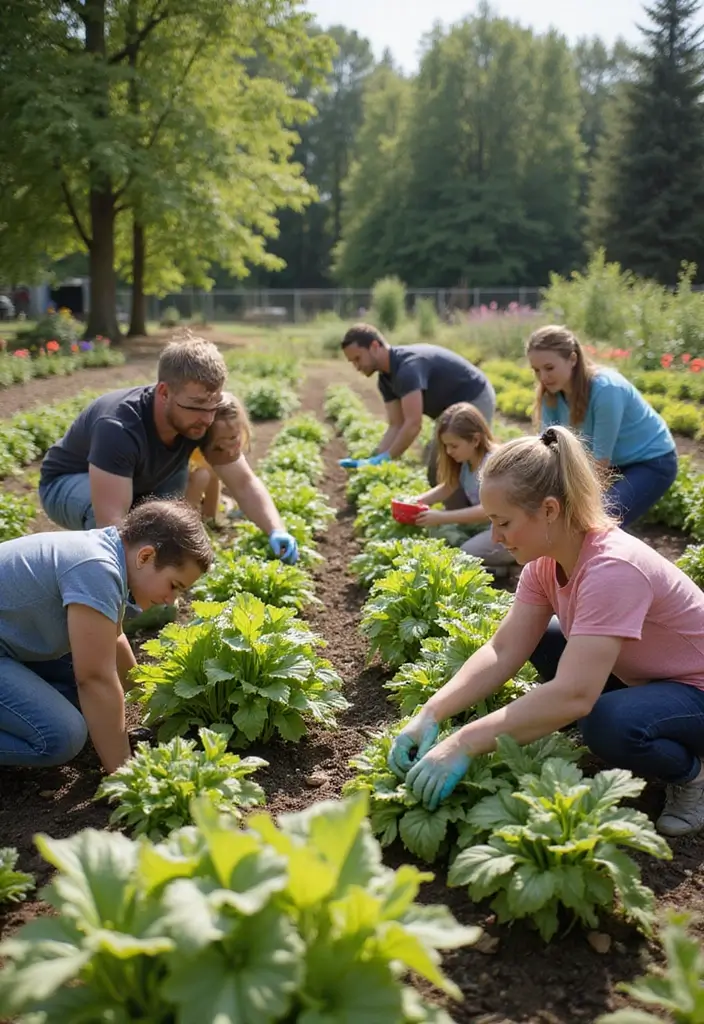
Join a community gardening club to foster relationships with fellow gardening enthusiasts! Community gardens are a great way to learn new skills, share resources, and enjoy the benefits of gardening, even with limited space.
Engage in your local gardening community by participating in workshops or classes offered in your area, and consider investing in some essential tools to enhance your experience. For instance, a reliable gardening tool set can make your gardening tasks easier and more efficient, whether you’re planting new seeds or maintaining existing plants.
Participate in group planting days or events, where you can also benefit from wearing a sturdy pair of gardening gloves. These gloves provide a firm grip and protect your hands while you work, allowing you to focus on the joy of gardening without worry.
Don’t forget to share your gardening successes and challenges with others. Being part of a community garden not only enhances your gardening knowledge but also builds friendships and promotes sustainability. If you’re looking to maximize your growing space, consider a raised garden bed kit, which is perfect for those with limited room but a desire to cultivate vegetables and herbs. With such resources at your disposal, your community gardening experience will be both fulfilling and productive!
24. Green Roofs
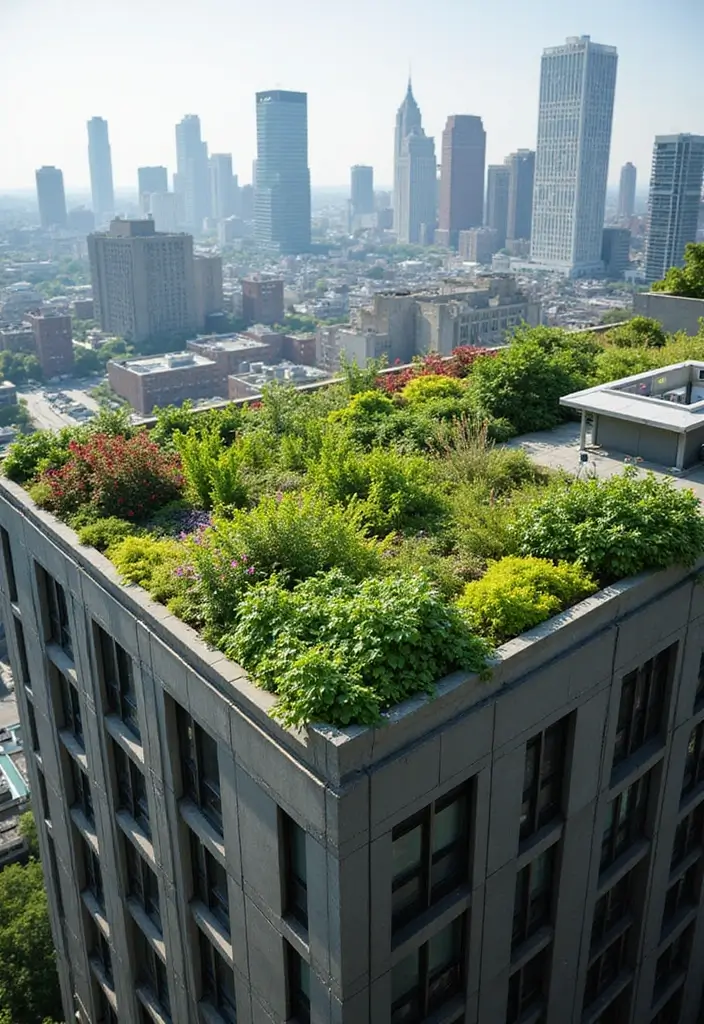
If you’re really short on space, consider a green roof! This innovative solution allows you to create a garden on your roof, improving insulation while providing green space.
To start a green roof:
– Consult with professionals to ensure structural integrity.
– Choose lightweight plants like sedums or mosses that can thrive in rooftop conditions. For instance, you might want to explore sedum plant varieties which are perfect for this environment due to their low maintenance needs and adaptability.
– Install proper drainage systems to prevent water damage. A great option for this is drainage mats, which will help manage excess water effectively.
Additionally, when it comes to housing your plants, consider using lightweight planters. These self-watering hanging baskets are ideal not only for saving space but also for ensuring that your rooftop garden remains vibrant with minimal effort.
Green roofs are not only practical but also contribute to reducing urban heat, making them a sustainable choice for city living.
25. Smart Gardening Technology
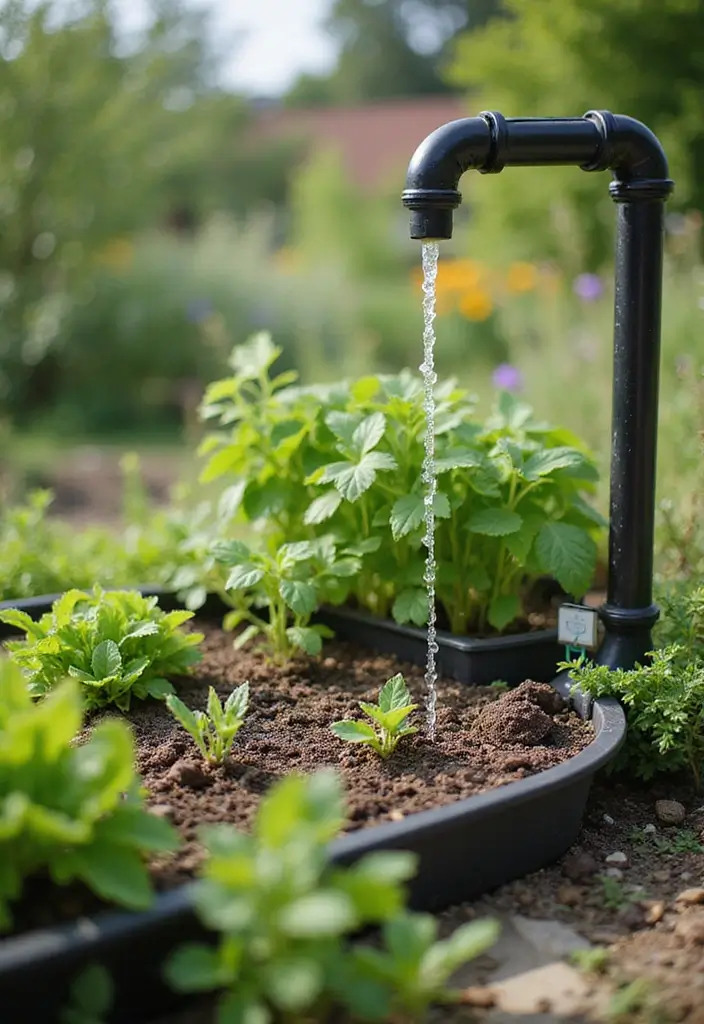
Embrace smart gardening technology to make your gardening experience easier and more efficient. From soil sensors to automated watering systems, technology can enhance your gardening game and help you maintain a thriving green space.
Consider these tech-savvy tips:
– Install a soil moisture sensor to monitor your plants’ watering needs accurately. This digital meter not only checks moisture levels but also measures temperature, pH, and sunlight intensity, ensuring your plants are always in optimal conditions.
– Utilize an app-controlled irrigation system like the LinkTap G2S. This smart irrigation tap timer allows for cloud-controlled watering, enabling you to save both water and time while keeping your garden healthy. Plus, its weather awareness feature helps adjust watering schedules automatically based on rain forecasts.
– Consider a smart planting kit that provides everything you need to start your garden easily. This hydroponics growing system comes with light and 12 pods, making it perfect for growing herbs and vegetables right in your kitchen.
Integrating technology into your gardening practices allows for more efficiency, making it easier to maintain your green paradise while maximizing growth!
26. Upcycled Container Gardens
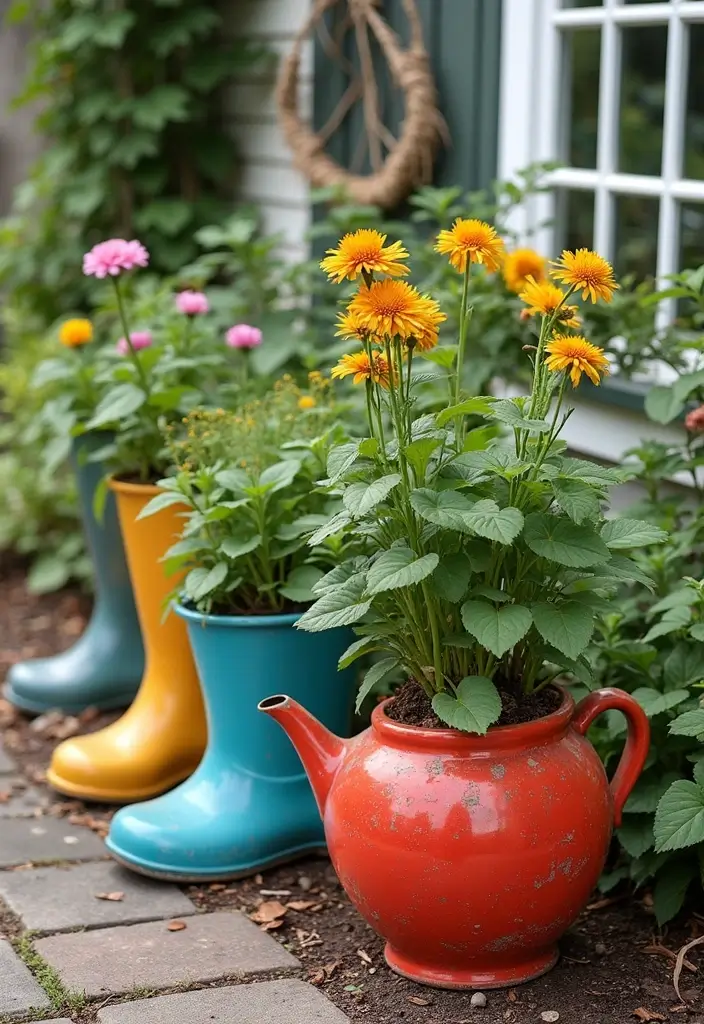
Get creative with upcycled container gardens using items you already have at home! Old boots, teapots, or tin cans can make fun and quirky planters. To ensure your plants thrive, it’s important to make sure there are drainage holes in your containers. You can easily create these holes using the drill with drill bits, which is perfect for making those umbrella holes in your repurposed items.
Don’t forget to clean your containers thoroughly, and if you want to add a personal touch, consider using non-toxic paint for upcycling. This versatile paint works well on a variety of surfaces, allowing you to customize your planters to fit your style.
When choosing plants, select varieties that suit the size and style of your containers. For assistance in picking the perfect indoor plants, refer to the indoor plant selection guide book, which provides valuable insights on caring for your green companions.
Upcycled container gardens bring out your personality and creativity while promoting sustainability by reusing materials. Happy gardening!
27. Biophilic Design
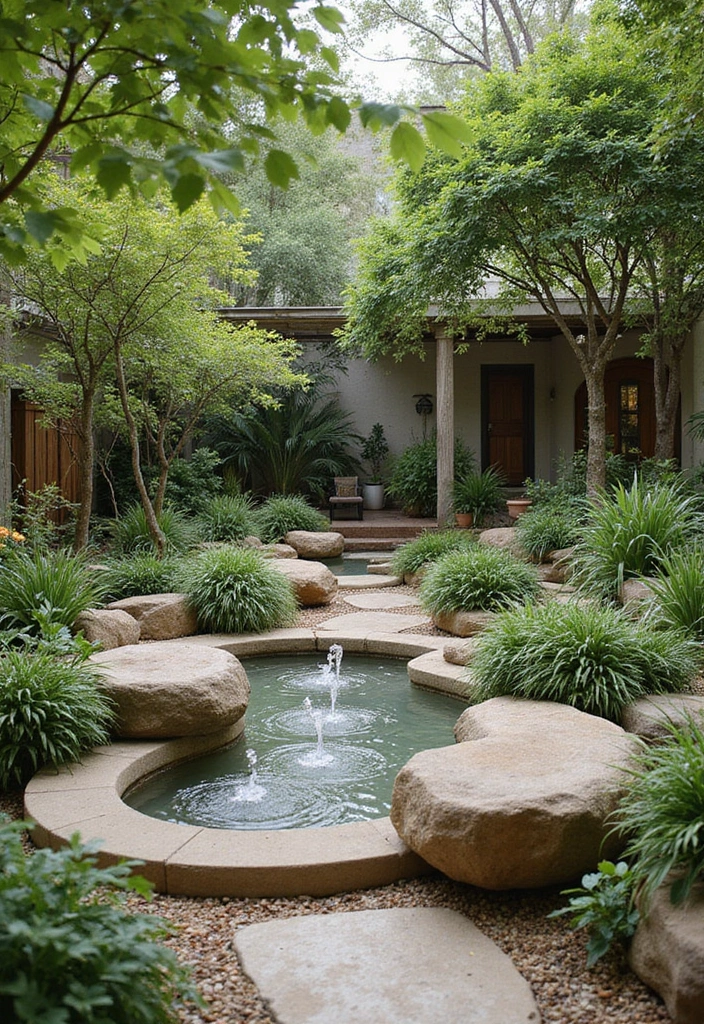
Incorporate biophilic design principles in your home and garden to deepen your connection with nature. This could involve integrating natural materials, plants, and water features into your living space.
Key elements include:
– Using wood, stone, and other natural materials in your garden design. For example, consider the natural wood planters like the acacia wood flower box. This durable square flower pot not only enhances the rustic charm of your garden but also provides an eco-friendly option for showcasing your favorite plants.
– Creating designated areas that focus on sensory experiences like the sounds of water or the scents of flowers. A wonderful addition to this concept is the water feature fountain. This indoor tabletop tiered fountain, featuring three candles, adds a soothing ambiance to your space, allowing you to enjoy the calming sound of flowing water even indoors.
– Positioning plants strategically in your home to bring nature indoors. Enhance your indoor environment with the delightful scented flower seeds, such as the white lilac. These non-GMO, heirloom seeds not only bring beautiful blooms but also fill your space with enchanting fragrances, contributing to a serene atmosphere.
Biophilic design promotes well-being and a sense of calm by enhancing your surroundings with natural elements. By introducing these thoughtful additions, you can create a thriving green space that connects you more closely with nature.
28. Seasonal Gardening Themes
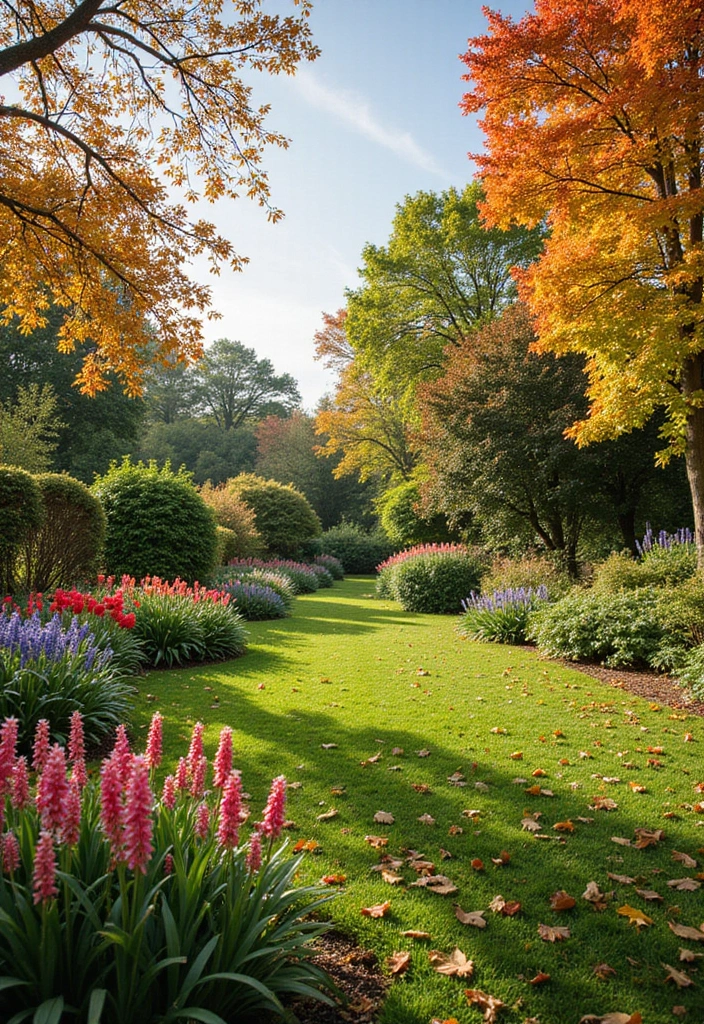
Embrace seasonal gardening themes to keep your space fresh and exciting throughout the year! Rotate your plant selections and decorations based on the season, custom-tailoring them to match the changing colors and moods of nature.
Consider enhancing your garden experience with a complete spring & summer 100 bulbs colorful blooming flower garden, which features beautiful flowers that attract bees, butterflies, and hummingbirds. These assorted flower bulbs are easy to grow and will bring vibrant life to your garden in the warmer months, making your space truly inviting.
As summer arrives, create a tropical oasis with vibrant hibiscus and sunflowers while adding a touch of whimsy to your decor. The Nacome solar garden outdoor statues turtle serves as a delightful lawn ornament adorned with a succulent and LED lights. This unique piece will not only brighten up your garden but also provide a charming focal point during the warm evenings.
When fall comes, incorporate pumpkins and autumn leaves for a cozy feel. To help you plan and cultivate your seasonal themes effectively, consider investing in the Complete Gardener’s Guide. This one-stop guide will assist you in planning, sowing, and growing your garden throughout the year, ensuring your gardening experience remains dynamic and enjoyable.
This approach adds variety and keeps your gardening experience engaging, ensuring there’s always something new to enjoy!
Conclusion
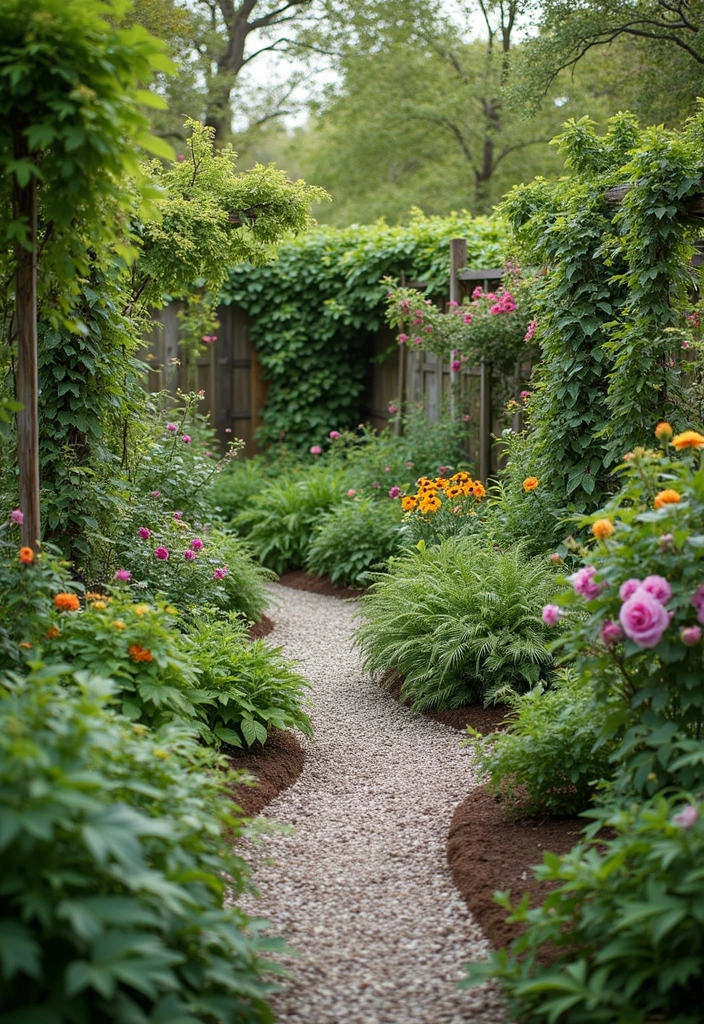
With these 28 home gardening ideas for small spaces, you’re well on your way to cultivating a thriving green space. Whether you choose to try vertical gardens, indoor plant care, or colorful container combinations, each idea enriches your life with beauty and sustainability.
Take your time, enjoy the process, and let your garden reflect your unique style and personality. Remember, gardening is a journey of discovery and connection with nature!
Note: We aim to provide accurate product links, but some may occasionally expire or become unavailable. If this happens, please search directly on Amazon for the product or a suitable alternative.
This post contains Amazon affiliate links, meaning I may earn a small commission if you purchase through my links, at no extra cost to you.
Frequently Asked Questions
What are some easy container gardening ideas for small spaces?
If you’re short on space, consider hanging baskets or vertical gardens! These ideas utilize height to display plants without taking up valuable floor space. You can also create a container vegetable garden on your patio or balcony, using a variety of pots or recycled containers to grow your favorite veggies!
How can I incorporate sustainable gardening practices in my home garden?
Sustainable gardening practices are all about working with nature! You can start by composting kitchen scraps to enrich your soil and practicing natural pest control methods to keep your plants healthy. Additionally, consider adding a pollinator-friendly garden to support local wildlife and enhance biodiversity in your green space.
What are some tips for indoor plant care?
Caring for indoor plants is all about finding the right balance! Make sure to choose plants that suit your home’s lighting conditions, and don’t forget to water them appropriately. For low-maintenance options, consider succulents or herb gardens in mason jars. Regularly dust off the leaves to keep them healthy and vibrant!
Can urban gardening solutions really provide fresh produce?
Absolutely! Urban gardening solutions like container gardens and raised beds make it possible to grow fresh produce even in the smallest of spaces. Using vertical gardening techniques or community gardens can also help maximize your yield while fostering a sense of community. You’ll be amazed at how much you can grow in a limited area!
What are the benefits of creating a community garden?
Creating a community garden offers numerous benefits! It’s a great way to connect with neighbors and share gardening tips while working together towards a common goal. Community gardens also promote sustainable practices, improve local biodiversity, and provide access to fresh produce for everyone involved. Plus, they can be a fun way to learn about gardening and enjoy the outdoors!
Related Topics

